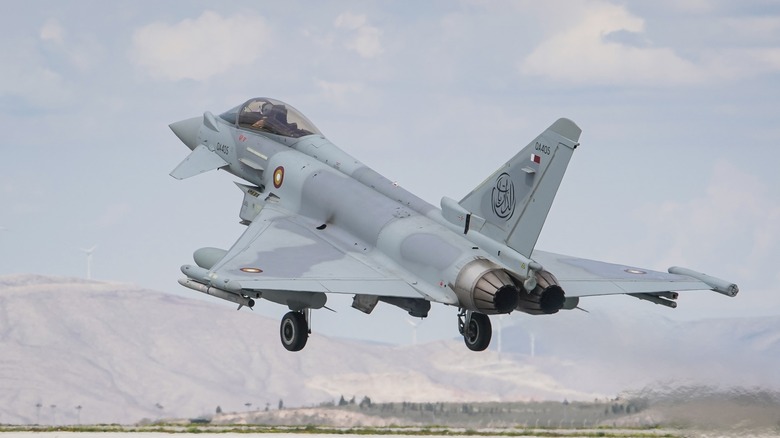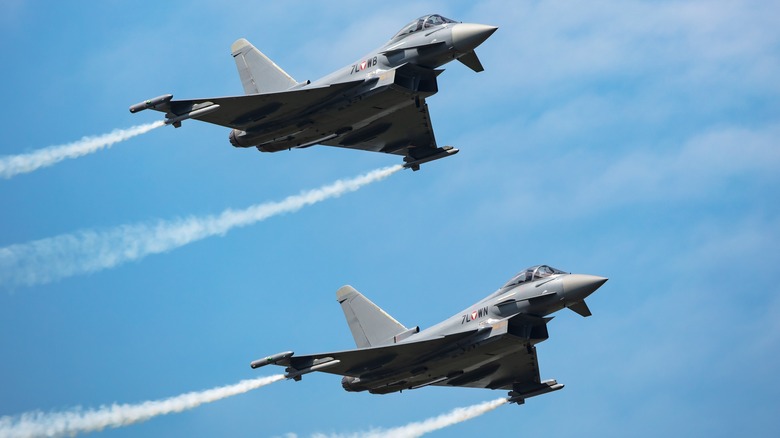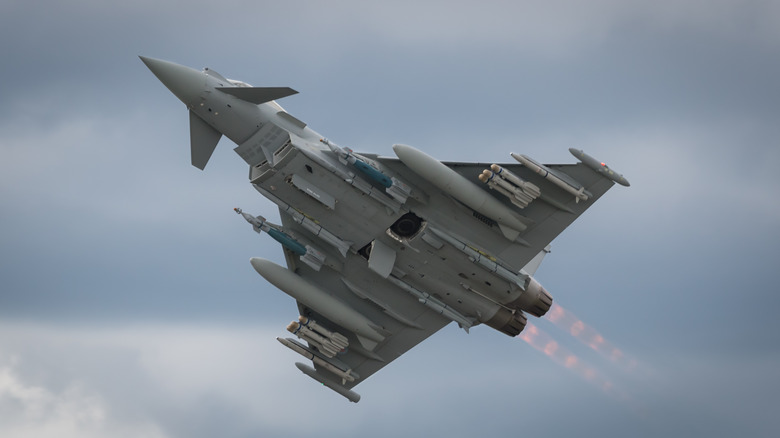How Much Fuel Can A Eurofighter Typhoon Jet Hold And How Far Can It Travel?
When you think of the advanced features on a military-grade fighter jet, what are the first things that come to mind? Weapons systems, thrusters, and pilot safety measures are all important features, but there's one that you might not have immediately landed on: fuel efficiency. Much like when you're buying a new car and want to be sure you're getting good gas mileage on your commute, fuel efficiency on a fighter jet is one of the most important things that a military force needs to consider. After all, greater fuel capacity and smarter fuel usage means more time the jet can spend in the air, doing the job it was assembled for.
Every fighter jet has different levels of fuel efficiency, contingent on the size of the fuel tank, along with the system of couplings that deliver fuel into the thrusters. Take the Eurofighter Typhoon, one of the best fighter jets ever built, which was the product of a collaborative effort between aerospace companies based in or around the European Union. This jet needs to cover enough ground to defend the entirety of the EU, so you'd better believe it's going to need some excellent gas mileage. But what kind of fuel system is the Typhoon packing, and just how far can that fuel carry it?
The Eurofighter Typhoon can carry over 8 tons of fuel
Creating a fuel delivery system for a fighter jet is a tricky process, as the whole body is regularly subjected to intense force. That means the system can't be too complicated, or it would only take a small jostle to throw the entire system out of whack. This is probably why the developers of the Eurofighter Typhoon decided to opt for a simple, streamlined means of fuel delivery.
The Typhoon utilizes a series of flexible couplings designed to swiftly and simply deliver the fuel through the main fuselages and wings. This makes it easier to connect and maintain the fuel tanks, which in turn all have matching fuel-flow proportions. The design also gives the entire jet a uniform center of gravity which, alongside a series of strategically-placed relief valves, helps to maintain the system's air and fuel pressure levels. The combined fuel tank can hold a maximum of 16,755 pounds (just over 8 tons), which is managed by an onboard computer system. Basically, this helps deliver fuel efficiently, allowing the jet to fly long distances without burning up its entire tank. Overall, this fuel can carry the jet 1,800 miles before it needs a refuel.
The Eurofighter Typhoon can reach Mach 2 at altitude
With its sizable fuel tank and highly-efficient delivery system, the Eurofighter Typhoon can stay in the air for a fairly lengthy period without refueling. Additionally, its lightweight engines are rated to fly for up to 1,200 hours before needing any kind of maintenance, sudden emergencies and combat situations notwithstanding.
The Typhoon is equipped with a pair of EJ200 engines, each of which puts out 90 kN of propulsion force. From a standstill, it takes less than 8 seconds for the Typhoon to take off, after which it can generate up to 180 kN of force with the afterburner turned on. While it's cruising at sea level, the Typhoon can breach Mach 1.25 to reach speeds of up to about 959 mph. Once it reaches altitude, the Typhoon can really open up, hitting Mach 2 at approximately 1,535 mph.
The Eurofighter Typhoon jet has its strengths and weaknesses, and it is meant to be a swing role vehicle. That means it can switch on the fly between air-to-air and air-to-surface combat and missions, although it might not be as strong as some of its competitors in the former division. Nevertheless, its impressive speeds and performance ensure the jet can serve multiple roles with the utmost urgency and efficiency.


